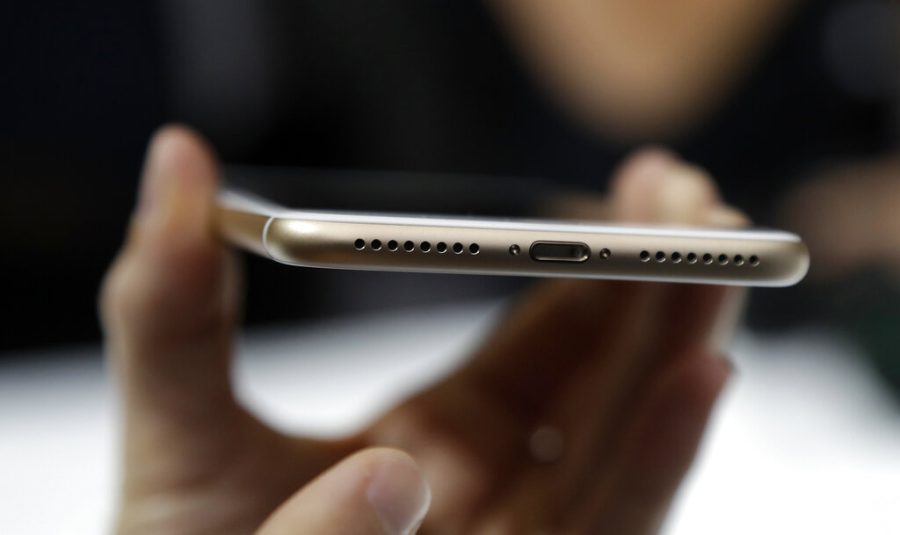What happened to the headphone jack?
In this Wednesday, Sept. 7, 2016, photo, the lightning port of an iPhone 7 is shown during an event to announce new Apple products, in San Francisco. The new iPhones are better, even when considering that the most dramatic change is what got taken away: the traditional headphone jack. Without a traditional headphone jack, wired headphones plug into the Lightning port normally used for charging. (AP Photo/Marcio Jose Sanchez)
When looking back on the tech world around 2016 and 2017, it’s almost impossible to miss the explosion of AirPods on the scene. Apple’s first home-branded foray into wireless earbuds became inescapable in the public consciousness, being seen everywhere from media, schools, and even in people’s ears while walking down the sidewalk. However, what the growing popularity of these would result in would be the death of a long-standing tradition in tech – the aux port.
For those wondering what an aux port was, it’s a simple port in which you would be able to plug wired headphones into without any external power to use., with no pairing or charging required. However, what Apple began to realize with the growing popularity of their wireless earbuds was that the perceived need for their wired offerings was waning. So, in a constant effort to cut costs, they would leave out the aux port on their next iPhone at the time being, the iPhone 7.
After, people were understandably upset. Their old earbuds, as well as their old and expensive wired headphones, were now incompatible with Apple’s new offerings. The solution? The now-infamous dongle.
A dongle, in the example of an iPhone, would convert the phone’s Lightning charging port to whatever you’d need it for – including an aux port. It removes the charging functionality while you’re using it, and it’s another accessory a consumer has to buy, coming in at $10 per aux dongle.
In efforts to defend the removal, AppleInsider states that Apple justified such by stating that, “Lightning would be a better standard for audio.” While this may be true for Apple, the consumer may still prefer to have the option to have a functioning headphone jack than have to use an adapter.
The consumer does struggle here. The choice for someone to make between a $30 pair of wired earbuds and a $120 pair of wireless earbuds shouldn’t have to be heavily skewed in one direction from the company making both of them, especially for someone who doesn’t understand that for the cheaper option, you need to buy an adapter to simply make them work.
Now, all of this is not to say that people may not prefer the option of wired headphones or earbuds. First of all, with most wired-only sets of headphones, external power isn’t required, and neither is charging. All of this makes wired earbuds more convenient the majority of the time. However, sound quality also plays a factor.
Wired earbuds take the digital audio files you’re listening to and directly convert them into the analog signals that you hear through the cables. When using Bluetooth headphones, the audio takes time to convert into analog signals, as no cables are present, often resulting in a delay and lower sound quality.
Taking this in-built choice away in the name of progress should never have become a trend, however, even companies that took pride in keeping the headphone jack would eventually turn away from the standard. Take Samsung, for example. Up until 2019, Samsung would continually run advertisements mocking Apple’s removal of the headphone jack and adoption of the dreaded dongle. However in 2019, when Samsung released its Note 10 phone without the jack present, they began pulling these ads, showing that they were seemingly going along with the trend of removing the standard.
The move was clearly anti-consumer. For wireless earbuds such as AirPods, you need at least 90 more dollars, possibly more accessories, a warranty, and have to deal with the possibility of losing them. With wired earbuds, you buy them for cheap, plug them in, and you’re ready to go.
When looking at devices today, whether they’re cheaper phones or more expensive laptops or portable music players, you might see auxiliary ports. Beforehand, you might think of them as run-of-the-mill, but nowadays, you’ll see them as having features that even Apple’s newest phones don’t have.












